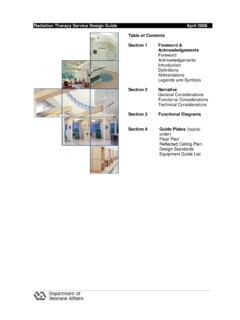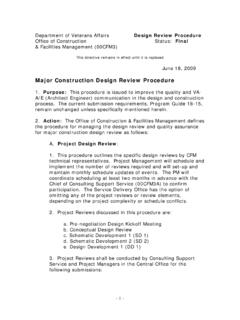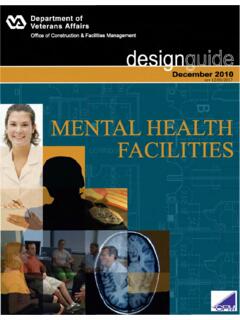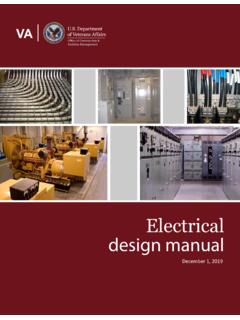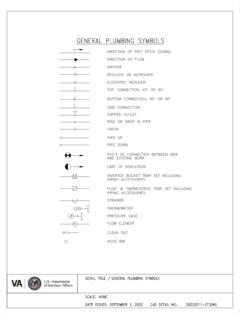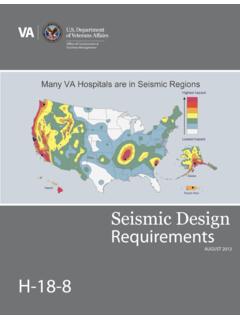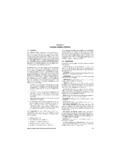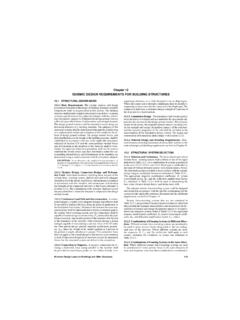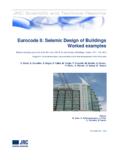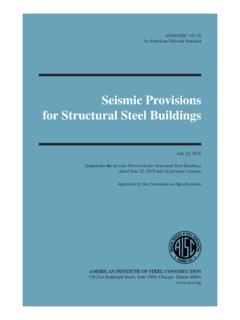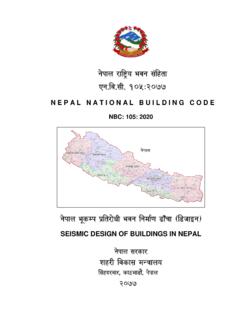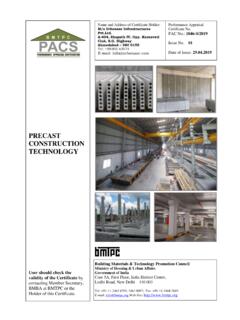Transcription of Revised May 1, 2020 H-18-8 - Veterans Affairs
1 Facilities Management seismic design Requirements November 1, 2019 Revised May 1, 2020 H-18-8 VA Handbook 18-8 November 1, 2019 seismic design Requirements Revised May 1, 2020 i FOREWORD Background In 1971, after the San Fernando earthquake resulted in the death of 46 patients and staff when two VA buildings collapsed, VA began to undertake a full seismic safety program. Title 38 - United States Code, section 8105 required the Secretary to assure that each medical facility constructed or altered shall be of construction that is resistant to fire, earthquake, and other natural disasters. This initiated the creation of the Secretary s Advisory Committee on Structural Safety of VA Facilities, which formally approved in 1975 the original VA seismic design document, H-08-8, Earthquake Resistant design Requirements for VA Facilities. These requirements were developed with the concept that all VA Essential Facilities must remain in operation after an earthquake and were far in advance of National Codes.
2 This document is periodically updated and Revised . The revision of H-08-8 to H-18-8 in 1995 was a major rewrite to bring VA seismic design requirements more in line with the updated national model codes. Further updates/revisions of minor nature were made in 1997, 1998, 2000, 2002, 2003, 2005, 2006, 2008, 2010, 2011, 2013, and 2016. Current Revision Highlights: Referenced versions of national codes and standards updated to the latest date-specific editions at the time this standard was published. Definitions of Critical, Essential, and Ancillary facilities have been clarified in Sections and Section corrects an error in the October 1, 2016 edition of H-18-8 that inadvertently excluded Ancillary facilities from the requirement to use nonlinear procedures for retrofit. Outdated exemptions for existing structures and nonstructural components and equipment were removed and the Importance Factor, Ip, for all nonstructural components is set to for Critical facilities in seismic design Categories C, D, E, and F, consistent with California s Office of Statewide Health Planning & Development (OSHPD) provisions.
3 In Section , reference to an outdated OSHPD Code Application Notice (CAN) regarding rugged equipment was replaced with lists of typical equipment requiring special seismic Certification and rugged equipment exempt from certification. Note: A vertical bar is placed to the right of the Revised sections. John G. Bulick Jr. November 1, 2019 Acting Associate Executive Director Office of Facilities Planning VA Handbook 18-8 November 1, 2019 seismic design Requirements Revised May 1, 2020 ii TABLE OF CONTENTS Definitions .. 1 General .. 3 Modifications to Requirements of IBC for New Critical and Essential Facilities Assigned to High seismic design Categories .. 6 Elements of Structures, Nonstructural Components, and Equipment Supported by Structures for Critical and Essential Facilities .. 9 Site Data for Critical and Essential Facilities .. 12 Commentary .. 14 Risk Categories.
4 16 VA Handbook 18-8 November 1, 2019 seismic design Requirements Revised May 1, 2020 1 DEFINITIONS AISC 3411: AISC 341-16, seismic Provisions for Structural Steel Buildings. ASCE 71: ASCE/SEI 7-16, Minimum design Loads and Associated Criteria for Buildings and Other Structures, American Society of Civil Engineers, . ASCE 411: ASCE/SEI 41 17, seismic Evaluation and Retrofit of Existing Buildings, American Society of Civil Engineers. Category of Facilities: a) Critical Facilities: Buildings and other structures that are intended to remain fully functional after the design level earthquake or other natural disaster such as hurricane, tornado, etc. These facilities include, but are not limited to, the VA occupancy categories listed as Critical Facilities in Tables 4 and 7, and they shall be assigned to Risk Category IV. b) Essential Facilities: Buildings and other structures that are intended to maintain essential functions with minor repairs after the design level earthquake or other natural disaster such as hurricane, tornado, etc.
5 These facilities include, but are not limited to VA occupancy categories listed as Essential Facilities in Tables 5 and 7, and they shall be assigned to Risk Category III. c) Ancillary Facilities: These buildings and other structures include, but are not limited to, the VA occupancy categories listed as Ancillary Facilities in Tables 6 and 7. All ancillary facilities shall be designated as non-essential facilities, and shall be assigned to Risk Category II. IBC1: 2018 International Building Code. OSHPD: Office of Statewide Health Planning & Development, State of California. Risk Category: A categorization of buildings and other structures used to determine natural hazard design loads based on the risk associated with unacceptable performance due to the nature of the occupancy, as defined in Section , and translated to IBC Risk Categories II, III, and IV specified in Section 1 Errata, addenda, supplements, and interpretations, if any, for this code or standard shall be adopted.
6 VA Handbook 18-8 November 1, 2019 seismic design Requirements Revised May 1, 2020 2 RP 81: Standards of seismic Safety for Existing Federally Owned and Leased Buildings, Interagency Committee on seismic Safety in Construction (ICSSC) Recommended Practice 8 (RP 8), The National Institute of Standards and Technology (RP 8 is available at ). seismic design Category: As defined in ASCE 7, a classification assigned to a structure based on its risk category and the severity of the design earthquake ground motion at the site. Soft Story & Extreme Soft Story: As defined in ASCE 7, Table Spectral Response Acceleration: A parameter used to characterize the anticipated earthquake shaking at the location of the specific facility under consideration. Ss: Spectral response acceleration parameter at short periods corresponding to the mapped maximum considered earthquake. S1: Spectral response acceleration parameter at a period of 1 sec corresponding to the mapped maximum considered earthquake.
7 SDS: design spectral response acceleration parameter at short periods adjusted for site class effects, as defined in ASCE 7. SD1: design spectral response acceleration parameter at a period of 1 sec adjusted for site class effects, as defined in ASCE 7. VA seismic Safety Coordinator: A VA Designated seismic Safety Coordinator in the Office of Facilities Planning (OFP) within the Office of Construction & Facilities Management (CFM), responsible for reporting VA compliance with Executive Order 13717, Establishing a Federal Earthquake Risk Management Standard. When the VA seismic Safety Coordinator is referenced in this manual for approvals, the Associate Executive Director for OFP also maintains the same approval authority. VA Handbook 18-8 November 1, 2019 seismic design Requirements Revised May 1, 2020 3 GENERAL These requirements cover all VA facilities including those of National Cemetery Administration, Veterans Benefits Administration, and Veterans Health Administration.
8 New Critical and Essential Facilities All new Critical and Essential Facilities shall be designed and constructed in full compliance with the earthquake design and detailing requirements of IBC as modified in these provisions. New Ancillary Facilities All new Ancillary Facilities shall be designed and constructed in full compliance with the earthquake design and detailing requirements of IBC with no additional modifications. Existing Facilities Evaluation and retrofit of all existing facilities shall comply with the minimum RP 8 standards as modified in these provisions, including triggers for evaluation and potential mitigation in Section Existing Facilities - Evaluation a. In addition to the RP 8 Section triggers, a seismic evaluation and potential mitigation shall be conducted for existing Critical and Essential facilities in areas where SDS and SD1 and Ancillary Facilities in areas where SDS and SD1 that meet one or more of the following criteria: i.
9 Facilities selected for renovation as part of a VA Major Construction project. ii. Facilities assigned to seismic design Category C, D, E, or F that are selected for renovation where the area of renovation is greater than 50% of the total area. iii A project is planned which significantly extends the building s useful life through alterations or repairs which total more than 30% of the replacement value of the facility. This applies for facilities assigned to seismic design Category C, D, E, or F. iv. Facilities under consideration by VA for lease with total floor area greater than 10,000 ft2. v. A significant addition to an existing building is planned that is not structurally independent of the existing building is planned. vi. A building is being relocated from its current site. b. Existing Critical, Essential, and Ancillary Facilities shall be evaluated using the procedures in ASCE 41 for the performance objectives in accordance with Table 1.
10 VA Handbook 18-8 November 1, 2019 seismic design Requirements Revised May 1, 2020 4 Existing Facilities Retrofit All Critical, Essential, and Ancillary existing facilities shall be retrofitted using Tier 3 nonlinear procedures described in ASCE 41 to achieve the performance objectives in accordance with Table 1. Existing Facilities Performance Objectives for Evaluation and Retrofit The performance objectives used for Evaluation and Retrofit are shown in Tables 1-3 and are defined in ASCE 41, and shall be applied for each applicable Tier (1-3) used for screening/evaluation and retrofit procedures. Table 1. Performance Objectives Description Evaluation Retrofit All triggered situations in Section and RP 8 Section , unless noted otherwise below BPON BPON Damaged structures described in RP 8 Section (d) BPOE BPOE Leased space BPOE BPOE Table 2. Basic Performance Objectives Equivalent to New Building Standards (BPON) Risk Categories seismic Hazard Level BSE-1N BSE-2N Critical and Essential Immediate Occupancy Structural Performance Life Safety Structural Performance Critical and Essential Operational Nonstructural Performance Hazards Reduced Nonstructural Performance Ancillary Life Safety Structural Performance Collapse Prevention Structural Performance Ancillary Position Retention Nonstructural Performance Hazards Reduced Nonstructural Performance VA Handbook 18-8 November 1, 2019 seismic design Requirements Revised May 1, 2020 5 Table 3.

